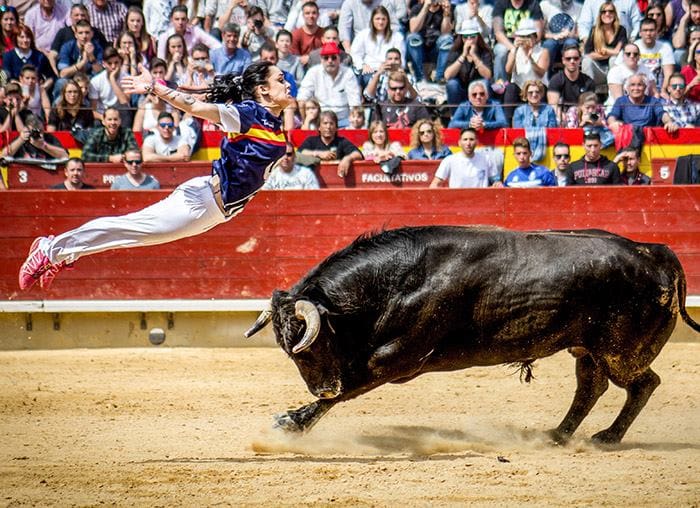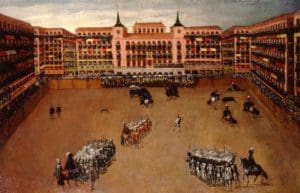The human and the bull
Archeological and artistic monuments discovered in the iberian Peninsula and as far as away of China provide ample evidence of the importance of bovine creature in the human civilzations since the Paleolitic age. They were depicted in the Pileta Cave Thousands years ago.
Mediterranean areas like Grece, Italy, France and Spain has evidences about play with bulls. In the bellow image a woman jumping over a bull in Creta, and the right side a conquest of “Recortadores” nowadays.


Taurocatpsia - el toreo popular de la edad antigua.
Taurocatapsia, first documented play with bulls. It is the origin of the current recortadores. A ancient ritual or show. It comes from Creta Grece.
Bullfighting in the midle edge.
Although killing bulls on foot was oullawed during the middle ages, popular games and combats were nevertheless practised in remote villages. The reconquest of Spain from Muslims domain and the emergence of new towns with more permissive laws led to the revival of popular fiestas with bulls. With the development of the urban way of life during the Reinaenscence period, the art of bullfighting finally spread to the big cities.
Austrias support bullfighting.

The house of Austria showed the keenest interest in bullfighting and the emperor Charles I would himself gore bulls. It was this dinasty that turned the art into a national spectacle by calling it the Royal show in reference to the fact that it was attended by the King, royal memebers of the royal family and courtiers.
Such was the admiration enjoyed by famous noblemen such as the Dukes of Maqueda and Pastrana, the marquis of Velada and the Earls of Cantillana and Villamediana hats the poets, Gongora, Quevedo and others versed about their feats with bulls.
The first treatises on bullfighting appeard in the eighteenth century whilest the current rules of the game were devised in the following century. The chaos confusion and wild emotions of popular fiestas gave way to structured spectacles structured in three parts and staged in emblematic buildings.
The prominence of the lanced-bearers of picadors, the leading figures in early bullfighting festivities remained until the middle of the ninetheeth century.
The matador
Thereafter however the importance began to wane in favour of the swordman or foot matador who developed a wide range of movements with the cape in a series of face to face encounters with the bull before going in for the kill with a short sword.
The taste for ostentatios displays, swerves and bold stances so characteristic of Sevillian Bullfighting bears a startk constrant to the authenticity severity and aplomb of the Ronda School.
Popular Bullfighting
You know that there are shows where the bull is not killed. This is Recortadores. Even the only one that can be hurt is the human. Let us show you the private world of bulls and come with us to see a breve bull ranch.
